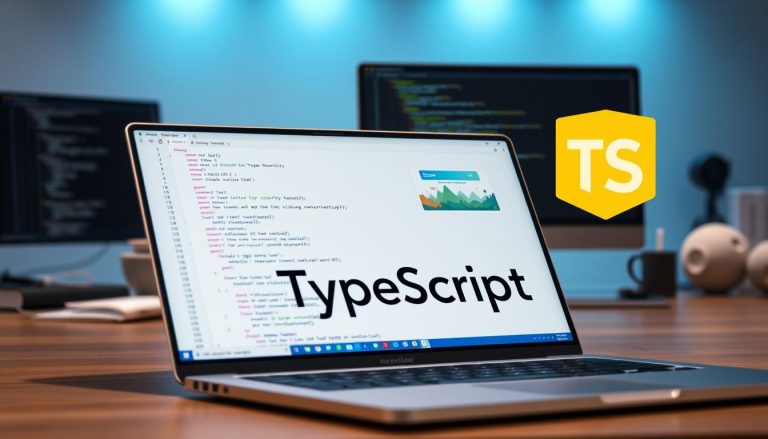TypeScript vs JavaScript: A Detailed Comparison Guide
What if the very flexibility that made a programming language a global phenomenon also became its greatest weakness for building today’s complex applications? This is the central question we explore as we dive into the relationship between two pivotal technologies in modern software creation.
JavaScript emerged in 1995, transforming simple web pages into interactive experiences. It has since evolved into a powerhouse capable of driving full-stack applications. Its dynamic nature offers incredible freedom but can introduce challenges in large-scale projects. TypeScript arrived in 2012 as a strategic enhancement, building directly upon the existing foundation. It introduces optional static typing and powerful tooling. This approach helps developers catch errors early and write more predictable, maintainable code.
We will dissect the core philosophies, practical applications, and ecosystem support for each language. Our goal is to provide a clear framework to help you make an informed decision for your next project.
Key Takeaways
- TypeScript is a superset of JavaScript, meaning any valid JavaScript code is also valid TypeScript.
- JavaScript’s dynamic typing offers flexibility, while TypeScript’s static typing enhances code safety and predictability.
- The choice between these languages significantly impacts project scalability, team collaboration, and long-term maintenance.
- JavaScript runs natively in all web browsers and remains the foundational language of the web.
- TypeScript has gained substantial adoption in enterprise environments for building large, complex applications.
- Understanding the trade-offs is essential for developers and teams to select the right tool for their specific needs.
- Both languages share the ultimate goal of creating dynamic, interactive web experiences.
Introduction to TypeScript and JavaScript
In the landscape of contemporary programming, two languages stand out for their complementary roles in application development. We begin by exploring their fundamental characteristics and significance in today’s digital world.
Overview of the Two Languages
JavaScript serves as the bedrock of web development, running directly in browsers since its 1995 introduction. This powerful programming language enables developers to create dynamic experiences without additional software.
TypeScript emerged in 2012 as Microsoft’s enhancement to the existing foundation. It adds static typing while maintaining full compatibility with standard code. This approach addresses scalability challenges in large projects.
The compilation process transforms TypeScript into executable JavaScript. This makes it a development-time tool that ultimately produces standard web-ready code.
Importance in Modern Web Development
Both languages play crucial roles across the entire application stack. JavaScript powers everything from simple interactions to complex single-page applications.
TypeScript has gained prominence in enterprise environments where long-term maintainability is essential. Many popular frameworks now default to or support this enhanced language.
The choice between these tools impacts development workflow, team collaboration, and project lifecycle. Understanding both has become essential for modern developers working in diverse environments.
Exploring JavaScript: Core Features and Use Cases
JavaScript’s approach to variable typing occurs entirely at runtime, providing developers with a flexible but potentially unpredictable coding environment. This fundamental characteristic shapes how we build interactive web applications.
Dynamic Typing and Flexibility
One of JavaScript’s most distinctive features is its dynamic typing mechanism. Variables can assume different types without explicit declarations, changing from numbers to strings during execution.
This flexibility enables rapid prototyping and quick iteration. Developers can write code without type annotations overhead, making it ideal for projects where speed matters more than compile-time safety.
The language excels at DOM manipulation, allowing real-time webpage updates in response to user actions. Event listeners create responsive interfaces that react immediately to clicks and keyboard input.
Asynchronous programming through promises and async/await enables non-blocking operations. This prevents interface freezing during data fetches from servers.
Ecosystem, Frameworks, and Community Support
JavaScript boasts a massive ecosystem with over a million npm packages. Numerous frameworks and libraries accelerate development by providing pre-built solutions.
Popular tools include React for component-based interfaces and Angular for enterprise applications. The active community provides extensive documentation and support forums.
This rich environment makes JavaScript suitable for both small projects and large-scale applications. The combination of flexibility and robust tooling continues to drive its widespread adoption.
Diving into TypeScript: Enhancing JavaScript with Static Typing
Static typing transforms how we approach application development by introducing compile-time safety. This powerful feature represents the core enhancement that TypeScript brings to the programming landscape.
Static Typing and Error Prevention
The static typing system requires explicit declaration of data types during development. This approach catches type errors before code execution.
Variables maintain consistent types throughout their lifecycle. This prevents common mistakes like calling string methods on numbers.
Early error detection significantly improves code reliability. Developers receive immediate feedback during the compilation process.
Advanced Features: Interfaces, Enums, and Generics
Interfaces define object structures with specified properties. This ensures consistency when working with complex data models.
Enums replace magic numbers with meaningful named constants. This enhances code readability and reduces typo-related errors.
Generics create reusable components that maintain type safety. They work with multiple data types while providing full type checking.
The language supports advanced type systems including union and intersection types. These features enable sophisticated type logic and narrowing within code blocks.
typescript vs javascript: Key Differences in a Nutshell
The distinction between these two programming approaches becomes most apparent when examining their fundamental handling of data types. We’ll explore how these differences impact daily development work and long-term project maintenance.
Type Systems: Dynamic vs Static
JavaScript employs dynamic typing, where variable types are determined during execution. A single variable can transition from storing text to holding numeric values without warnings.
TypeScript introduces static typing that validates types before code runs. This system requires explicit declarations like
1 | : string |
or
1 | : number |
when creating variables.
The syntax variation appears minor but delivers major benefits for code reliability. Static checking catches mismatches early, preventing runtime errors that can be difficult to debug.
Tooling, IDE Support, and Development Experience
Development tools leverage TypeScript’s type information to provide superior support. Integrated development environments offer intelligent code completion and refactoring capabilities.
JavaScript development provides immediate browser feedback without compilation steps. However, tooling support remains more limited due to the language’s dynamic nature.
TypeScript requires a compilation phase that adds time but enhances code quality. The resulting JavaScript maintains full compatibility with existing libraries and frameworks.
For large codebases, the static approach significantly improves maintainability. Developers spend less time debugging and more time building features.
Performance and Scalability in Web Development
When building applications that must scale to meet growing user demands, development teams face critical decisions about their technology stack. The performance conversation extends beyond raw execution speed to encompass long-term maintainability and team productivity.
Both languages compile to identical runtime code, meaning execution performance remains the same. Any differences emerge from how developers structure their code rather than inherent language characteristics.
Impact on Code Maintainability
The real advantage appears during the development phase. Static typing enables IDEs to validate changes against entire codebases instantly. This catches potential issues that would require extensive testing to discover in dynamically typed environments.
As applications grow from thousands to hundreds of thousands of lines, explicit type annotations become invaluable. They help developers understand component interactions without reading through entire implementations.
This approach significantly reduces debugging time. Type-related errors surface during compilation rather than at runtime. Teams spend less time troubleshooting and more time building features.
Key maintainability benefits include:
- Living documentation that stays synchronized with code changes
- Safe refactoring capabilities with compiler-guided updates
- Clear component boundaries through interfaces and modules
- Reduced risk of breaking changes during updates
For smaller projects where speed matters most, the lack of compilation overhead can be advantageous. However, as large applications evolve, the scalability benefits become undeniable.
Integrating Tools and Frameworks for Modern Apps
Modern application development relies heavily on robust frameworks and tools that accelerate the creation process. These resources provide pre-built components and standardized approaches to common challenges.
Both programming languages benefit from the same extensive ecosystem of libraries and development tools. This shared foundation ensures compatibility across different project requirements.

Leveraging JS Ecosystem and Modern Frameworks
Popular frameworks like React, Angular, and Ext JS offer comprehensive solutions for building sophisticated applications. Each provides unique advantages for different development scenarios.
Ext JS delivers enterprise-grade components with extensive pre-built functionality. Its 140+ UI elements work seamlessly across both language environments.
React’s component architecture gains enhanced type safety through additional tooling support. This combination catches errors during the development phase.
Angular embraces static typing as its foundational approach from the beginning. The framework leverages advanced language features for large-scale applications.
The tooling ecosystem includes package management, testing frameworks, and build tools. These resources require minimal configuration adjustments for different project setups.
Developers can gradually introduce enhanced typing into existing codebases. This incremental approach makes adoption practical for teams of all sizes.
Choosing the Right Language for Your Project
Making the right choice between these programming approaches requires careful consideration of several project-specific factors. We provide a practical framework to guide your decision based on real-world development scenarios.
Project Scale and Complexity Considerations
For small projects and rapid prototypes, the dynamic approach offers significant advantages. Quick iteration cycles and immediate testing capabilities accelerate initial development.
Large-scale applications with complex data models benefit from static typing’s safety features. The explicit type definitions serve as living documentation that scales with your codebase.
Learning Curve and Community Support
Beginners often find the dynamic language more accessible for learning fundamental concepts. The reduced cognitive load allows focus on core programming principles.
Experienced developers can leverage static typing’s advanced features for more robust applications. Both languages enjoy strong community support and extensive learning resources.
Key decision factors include:
- Team size – Larger teams benefit from explicit type contracts
- Time constraints – Tight deadlines may favor rapid development cycles
- Long-term maintenance – Extended projects gain from compile-time safety
- Browser compatibility – Both support targeting specific runtime environments
The choice isn’t necessarily permanent. Many teams start with one approach and gradually adopt the other as project needs evolve. This hybrid strategy balances immediate productivity with long-term maintainability.
Conclusion
As we conclude our exploration, it becomes clear that both approaches serve distinct but equally valuable roles in the programming ecosystem. The choice between them depends entirely on project requirements rather than technical superiority.
We find that static typing and advanced features make one language ideal for enterprise applications where maintainability matters. The other excels in rapid prototyping and smaller projects where flexibility takes priority.
Both languages share the same extensive ecosystem of frameworks and tools. This ensures developers can leverage popular technologies regardless of their chosen implementation path.
We encourage programmers to gain proficiency in both approaches. Understanding fundamentals remains essential, while advanced skills become increasingly valuable. For deeper insights into these programming choices, we recommend exploring comprehensive comparisons that detail specific use cases.
The ongoing evolution of web technologies ensures both languages will continue serving complementary roles. Each addresses different development challenges while maintaining runtime compatibility and supporting the diverse needs of modern applications.
FAQ
What is the main difference between TypeScript and JavaScript?
Is TypeScript a completely different programming language from JavaScript?
Can I use existing JavaScript libraries and frameworks with TypeScript?
Does using TypeScript affect the runtime performance of my application?
When should I choose TypeScript over JavaScript for a new project?
Is the learning curve for TypeScript steep for a JavaScript developer?
- About the Author
- Latest Posts
Mark is a senior content editor at Text-Center.com and has more than 20 years of experience with linux and windows operating systems. He also writes for Biteno.com






